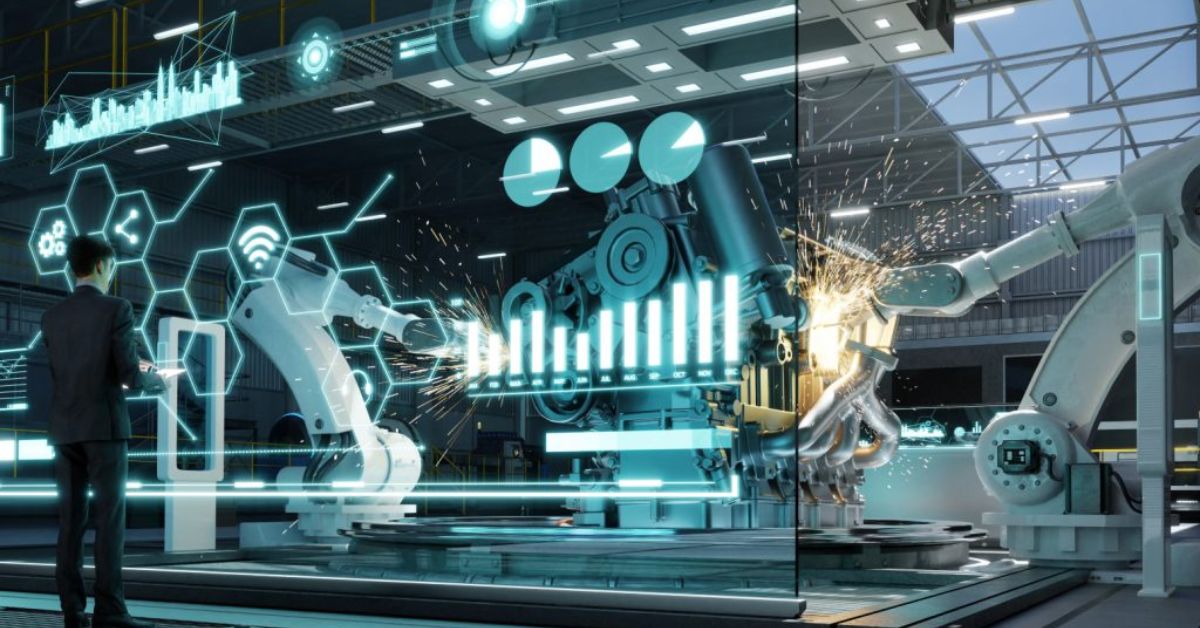The manufacturing industry in the United States is undergoing a massive digital transformation. From automation and artificial intelligence to smart data analytics, the adoption of modern manufacturing technologies is reshaping how goods are designed, produced, and distributed. These technologies not only improve productivity and accuracy but also make manufacturing more sustainable and cost-efficient. In this comprehensive guide, we’ll explore 12 Examples of Manufacturing Technologies that are redefining the future of U.S. factories, plants, and industrial systems.
12 Examples of Manufacturing Technologies
The term manufacturing technology refers to the tools, equipment, and software systems that enhance production efficiency and quality. In the U.S., these advancements are creating a new era known as Industry 4.0, where digital tools, IoT, and AI work together to drive innovation. The following sections highlight the twelve most impactful manufacturing technologies that have already begun revolutionizing the American industrial landscape.
Manufacturing Technology #1: IoT Connections
The Internet of Things (IoT) connects machines, sensors, and devices across the production line, allowing manufacturers to collect and analyze massive amounts of data in real time. In the United States, automotive and aerospace industries use IoT to monitor machinery health, predict failures, and reduce downtime. A connected factory floor powered by IoT helps decision-makers identify inefficiencies instantly. According to McKinsey, smart factories using IoT can increase productivity by up to 30%. For example, Ford uses IoT-driven analytics to optimize assembly line performance and energy consumption, ensuring higher output with lower costs.
Manufacturing Technology #2: Simulation Software
Simulation software enables manufacturers to create digital models of production systems before building them physically. This technology allows engineers to test various designs, workflows, and equipment setups without risking production delays. U.S. manufacturers rely heavily on simulation to minimize material waste and optimize process flow. Boeing, for instance, uses simulation tools to design aircraft components and simulate flight performance before manufacturing. The use of simulation reduces testing time, improves safety, and ensures product reliability.
Manufacturing Technology #3. Digital Twins
Digital twins are virtual replicas of physical machines, systems, or processes. They help manufacturers monitor, analyze, and optimize operations using real-time data. In the U.S., companies like General Electric use digital twins to track jet engines, predicting maintenance needs before breakdowns occur. This approach saves millions in downtime costs. The digital twin concept blends IoT, data analytics, and AI to create intelligent feedback loops between the physical and virtual worlds, resulting in smarter manufacturing decisions and improved asset performance.
Manufacturing Technology #4: Supervisory Control and Acquisition Data/Human-Machine Interface Software
Known as SCADA/HMI, this technology serves as the backbone of modern manufacturing automation. It enables engineers to visualize complex processes, monitor equipment, and control operations remotely. SCADA systems collect real-time data from sensors and devices, while HMI provides a user-friendly interface for operators. In American manufacturing plants, SCADA/HMI software ensures safety, prevents system overload, and supports data-driven maintenance. Industries such as energy, food processing, and automotive rely on it for consistent, high-quality production.
Manufacturing Technology #5: Real-Time Location Systems
Real-Time Location Systems (RTLS) are among the most impactful Examples of Manufacturing Technologies used in modern industries today. These systems allow manufacturers to track assets, tools, and personnel within factories with remarkable precision. By using sensors and RFID tags, companies gain full visibility into equipment usage and employee movement patterns. In the U.S., logistics and warehouse operations depend on RTLS to streamline workflows, enhance safety, and minimize operational errors. A study by Deloitte reveals that implementing RTLS can boost inventory accuracy by more than 90%. Major automotive suppliers now rely on this smart technology to ensure that critical components reach the assembly line exactly when needed, reducing downtime and optimizing overall production efficiency.
Manufacturing Technology #6: Augmented Reality
Augmented Reality (AR) is transforming how training, maintenance, and production processes are performed. AR overlays digital instructions or visuals onto the real world through smart glasses or tablets. American companies like Caterpillar and Lockheed Martin use AR to assist technicians in assembling complex machinery. This reduces human error and enhances training efficiency. When workers can visualize digital blueprints directly in their field of view, it shortens learning curves and improves safety.
Manufacturing Technology #7: Robotics
The U.S. manufacturing sector has seen a surge in robotics, reshaping how products are made. Robots handle repetitive, dangerous, or highly precise tasks with unmatched accuracy. There are several categories of robotics used in manufacturing.
Industrial Robots
These heavy-duty robots perform welding, painting, and material handling in large-scale factories. Companies like Tesla rely on industrial robots to assemble vehicles faster and with higher precision.
Collaborative Robots
Known as cobots, these machines work safely alongside humans. They are cost-effective, easy to program, and perfect for small and mid-sized American manufacturers. A food packaging company in Ohio recently integrated cobots to assist workers, improving output without replacing jobs.
Mobile Robots
Autonomous Mobile Robots (AMRs) move materials around factory floors without human supervision. In e-commerce warehouses, AMRs deliver parts between stations, optimizing efficiency and reducing bottlenecks.
Exoskeletons
Wearable exoskeletons support workers physically, reducing strain and preventing injuries. Construction and manufacturing employees in the U.S. now use powered suits to lift heavy tools safely, boosting both health and productivity.
Manufacturing Technology #8: Manufacturing Execution Systems
Manufacturing Execution Systems (MES) act as the digital link between factory floor operations and corporate planning systems. They track every step of the production process, from raw material input to product shipment. U.S. manufacturers use MES to maintain product quality, traceability, and compliance. By integrating MES with IoT and ERP systems, companies gain full visibility of performance metrics and can make instant process adjustments to meet customer demand efficiently.
Manufacturing Technology #10: Private 5G Networks
Private 5G networks are redefining communication within U.S. manufacturing plants. Unlike public networks, private 5G offers faster data transmission, lower latency, and stronger security. These networks enable seamless machine-to-machine communication and real-time control of robotics and sensors. According to Verizon, 5G-driven automation can reduce operational costs by up to 20%. American automakers are among the early adopters, leveraging private 5G to enable connected vehicles and smart factory systems.
Manufacturing Technology #11: Smart Manufacturing Platforms
Smart manufacturing platforms represent some of the most advanced Examples of Manufacturing Technologies driving innovation across the United States. By combining cloud computing, big data, and analytics, these platforms integrate every aspect of production into a unified digital ecosystem. They deliver valuable insights into machine performance, energy consumption, and maintenance requirements. In the U.S., industries use smart manufacturing platforms to predict equipment failures, reduce downtime, and optimize workflow. A great example is Honeywell’s Forge platform, which collects and analyzes data from factories around the world to improve operational efficiency, reduce waste, and promote sustainability in modern manufacturing.
Manufacturing Technology #12. Generative AI and Agentic AI
The rise of Generative AI and Agentic AI is changing how manufacturers design, plan, and operate. Generative AI uses algorithms to create new product designs or optimize existing ones, while Agentic AI enables autonomous decision-making. American manufacturers are using these technologies to enhance supply chain resilience and design innovation. A case study from Autodesk shows how AI-driven design reduces product development time by 40%, saving millions in R&D
Technology Investments In Mining
The mining industry in the United States is leveraging advanced technologies like automation, drones, and IoT sensors to boost efficiency and safety. Predictive analytics helps detect equipment wear and tear before failure. Automation in drilling and ore transport reduces human risk and improves accuracy. Digital mapping and data visualization tools also help monitor environmental impact, supporting sustainable resource management.
Technology Investments In Pharmaceuticals
In the pharmaceutical sector, manufacturing technologies ensure precise production, quality control, and regulatory compliance. Robotics and AI-powered analytics accelerate drug formulation, while IoT monitoring guarantees consistent temperature and humidity in storage and packaging. U.S.-based companies like Pfizer and Johnson & Johnson use digital twins to simulate production lines, enhancing safety and reducing batch errors.
Technology Investments In Consumer Packaged Goods
The consumer packaged goods (CPG) industry is one of the best real-world Examples of Manufacturing Technologies transforming large-scale production in the United States. By integrating smart manufacturing platforms and IoT solutions, CPG companies can streamline production and enhance efficiency at every stage. These advanced technologies allow real-time monitoring, predictive maintenance, and fully automated packaging systems. Major brands like Procter & Gamble leverage data analytics to minimize waste, cut energy usage, and maintain consistent product quality across their facilities. This intelligent use of connected manufacturing systems highlights how digital transformation is reshaping the CPG sector’s competitiveness and sustainability.
Vendor Examples
Several technology vendors are leading the digital manufacturing revolution in the United States. Their innovations provide scalable and reliable solutions for businesses of all sizes.
Manufacturing Technology Vendor #1: MindSphere
MindSphere, developed by Siemens, is a cloud-based industrial IoT platform that connects machines and systems. It gathers real-time data to optimize operations, predict failures, and improve energy efficiency.
Manufacturing Technology Vendor Example #2: Zemax
Zemax specializes in optical design software that supports advanced product development. Its simulation tools are widely used in manufacturing industries like electronics and healthcare to improve precision and reduce prototype costs.
Manufacturing Technology Vendor Example #3: Roambee
Roambee provides IoT-based monitoring solutions that track shipments and assets across global supply chains. U.S. manufacturers use Roambee to ensure visibility, security, and efficiency in logistics management.
May Also Read: How to Create PUBG ID – Complete Step-by-Step Guide for Beginners
Conclusion
The 12 Examples of Manufacturing Technologies discussed here represent the future of smart, connected, and data-driven production in the United States. From IoT connections to Generative AI and Agentic AI, these technologies are not just enhancing productivity—they’re redefining what’s possible in modern manufacturing. As industries continue to adopt digital twins, robotics, and smart platforms, America’s manufacturing sector is poised for a more innovative and sustainable future.
In the years ahead, the most successful manufacturers will be those that embrace this transformation—investing in automation, connectivity, and intelligence to lead the next industrial revolution.


